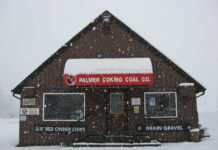In the early days of Black Diamond’s development, transportation was the key to the town’s success. For without a railroad there could be no coal mine, but without a coal mine the railroad wouldn’t be built. So the Black Diamond Coal Mining Company helped finance building the extension of the Columbia & Puget Sound Railroad from Renton that also served the Oregon Improvement Company’s nearby Franklin mines.
Once the railroad reached Black Diamond in 1884, it wasn’t long before the depot in this 1915 photo was built. Back then there were two trains a day, one at 10 a.m., and the passenger train arriving at 6 p.m. Meeting the train in the early 1900s was a favored entertainment in the days before radio and telephone. The Black Diamond depot was built by and operated by the railroad.
By 1925, even the newsletter of the Pacific Coast Company that owned the railroad admitted that times had changed. “Years ago the railroad depot was the most popular place in every small city or town, and the daily arrival of the Limited was an event seldom missed by the population. Automobiles and motor stages have changed all this, however, and today the highway is more popular than the railway.” That year regular passenger service ended, though it continued until 1931 for Black Diamond miners commuting to and from the New Black Diamond mine located about four miles south of Renton on the Maple Valley Highway. With passenger service ending and coal production in decline, the depot era concluded, and the building was used asarestaurant, library, telephone exchange, city water department, and storage of maintenance supplies. The last coal train left Black Diamond in April 1969.
The United States’ bicentennial in 1976 caused town folk to begin thinking about the old depot in a new light. The Black Diamond City Council appropriated $500 to begin a renovation and turned the building over to a group who soon organized the Black Diamond Historical Society. The founding members who adopted the Articles of Incorporation on January 26, 1976 were: Carl H. & Ann C. Steiert, Frank F. Guidetti, Verna Thompson, Joe L. & Dolores I. Wilkening, Louis J. Zumek, Frank R. Costi, Charles J. & Patricia L. Holtz, and Howard L. Botts.
After six years of demanding work by volunteers showing up each Thursday, the museum was dedicated on June 6, 1982, to honor the 100th anniversary of Black Diamond’s founding. Inside the museum is a wonderland of displays including a miniature underground coal mine where cars of coal can be seen climbing out of the mine on rails, just like the days of old. The depot grounds feature a locomotive, caboose, jailhouse, coal mining equipment, and the Coal Miners Honor Garden where the names of those who died in Washington State coal mines are listed.
This Saturday, June 15th, Black Diamond celebrates its 20th Anniversary of Miners Day from 9 to 4. Railroad Avenue will be closed, and the Museum open to welcome visitors. There will be food trucks, face painting, live music, donut eating contest, a dog and wagon parade, Keystone Cop skit, kids’ activities, and more. This photo was scanned from a Pacific Coast Company photo album and comes courtesy of Palmer Coking Coal Co., with a similar image #1978.6585.29 held by the Museum of History and Industry (MOHAI), located at South Lake Union in Seattle.







